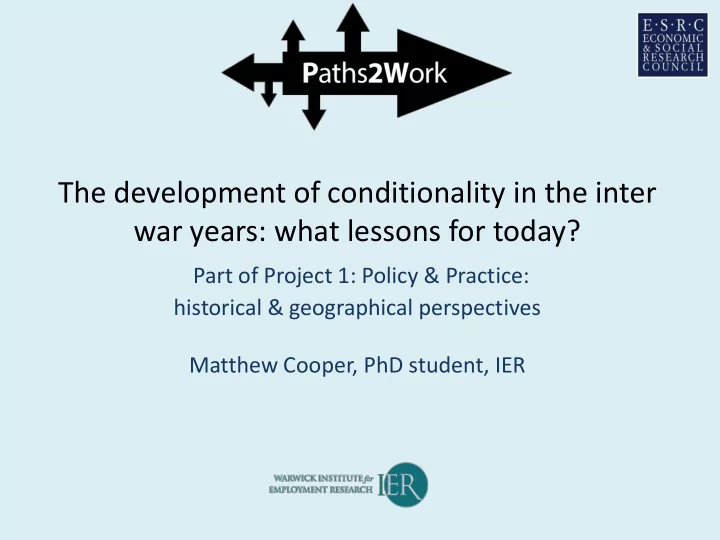

The development of conditionality in the inter war years: what lessons for today? Part of Project 1: Policy & Practice: historical & geographical perspectives Matthew Cooper, PhD student, IER
Welfare reform since 2010 Characterised by… • Claimants viewed as ‘workless’/’dependency culture’. As poorly socialised through ‘intergenerational worklessness’. Requiring paternalist regulation. • Methods include: Increasing job search expectations + severity of sanctions, unpaid work.
Two analogous periods • Economic crisis; Recession and depression • A dominant liberal ‘political rationality’ in each period, austerity seen as crucial to national recovery.
Theoretical approach • Follows Discipline & Punish: “the intervention of the state through organisations, procedures, rules and categories” (Boland 2015). Discipline understood as a ‘constructive power’ • An “'active system' of income support for the unemployed not only acts upon the financial plight of the unemployed, and upon their job prospects, but also upon those attitudes, affects, conduct and dispositions that present a barrier to the unemployed returning to the labour market, and alienate them from social networks and obligations” (Dean 1995 :572).
Sources Files at: • The National Archives: Ministry of Labour, Unemployment Assistance Board, Ministry of Health • Birmingham Library: Birmingham Public Assistance Comittee • Modern Records Centre, University of Warwick: TUC files This Photo by Unknown Author is licensed under CC BY-SA
The establishment of a Social Security System- some milestones • 1909 Labour Exchange Act • 1911 Introduction of Unemployment Insurance • 1918 Out of Work Donation brought in for the uninsured • 1921 Uncovenanted Benefit replaced the Donation. Introduction of Genuinely Seeking Work Test • 1929 Local Government Act, introduced Public Assistance • 1930 Abolition of Genuinely Seeking Work Test • 1934 Introduction of Unemployment Asistance
Moral Ordering in benefits in the 1930s Unemployment benefits divided between • Insurance based benefit: available as of a right for 6 months. Little conditionality. • Extended Benefits: Actively Seeking Work test from 1921 to 1930. After this point policed through the offer of work. • Public Assistance (from 1929) and the Poor Law: For those with insufficient contributions (ran locally). Birmingham: Means test, unpaid work, workhouse, all rates discressionary.
Conditionality and enforcement • Active job search enforcement: Rejected by 1930s • Instead needed Exchanges to locate vacancies which could be used to identify the unwilling • Compulsory work and training debated for the Extended group. But mainly applied in Public Assistance.
Similarities and differences? Similarities Differences • • Construction of claimants as in Welfare reform involves need of intervention to category collapse integrating maintain or instil personal distinct status and making discipline. Dependency/De- ‘moral ordering’ opaque. moralization. • Loss of higher status position • Behavioural interventions of the insured contributor. which have the ‘state of mind’ • Different models of the career of the applicant as object. and security, linked to • Continuity of institutional different models of political techniques, the rebirth of task economy. work, job search conditions.
Thank you for your attention. Contact us: matthew.cooper@warwick.ac.uk www.warwick.ac.uk/paths2work @_MatthewCooper
Recommend
More recommend